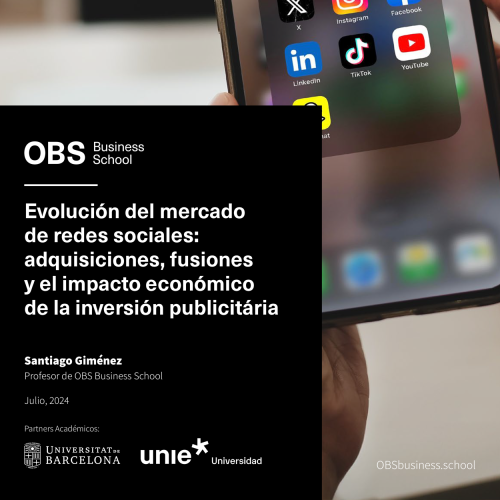
OBS Report: Social Media Market Evolution 2024
62% of the world's population uses Social Media; over 80% in Western Europe
- 5.04 billion people use social networks worldwide, 5.6% more than last year. They use them for an average of 2 hours and 23 minutes every day.
- Facebook is the most used with an increase of 3.1% in the last year. YouTube has lost 0.91% of its users.
- Acquisitions and mergers in the sector allow the expansion of capacities, the integration of new technologies and the increase of market share, but there is a risk of monopoly, although this also encourages innovation.
- Social media advertising reached USD 207.1 billion in 2023, a growth of 9.3%. Meta leads advertising revenues with $117.9 billion.
- AI will transform social media and, among other things, automatically identify and moderate harmful or inappropriate content, misinformation, hate speech and abuse.
June 2024. OBS Business School, an institution belonging to Planeta Formación y Universidades, publishes the report Evolución del mercado de redes sociales, directed by Professor Santiago Giménez. The document focuses on three key aspects of the sector: current statistics and data, recent acquisitions and mergers, and the economic outlook for advertising investment.
The use of social networks
There are currently more than 5.04 billion social network users in the world, 5.6% more than last year. This represents more than 62% of the world's population. The average browsing time is 2 hours and 23 minutes per day, although this varies according to age and gender: women aged 16-24 spend the most time on social networks; men aged 55-64 the least. In proportional terms, Northern Europe is the area with the highest use of social networks, 81.7% of the total population. In Western Europe these figures are 80.2%, in the US 71.3%, in South America 66.4% and in Central America 65.1%.
Facebook remains the world's most used social platform with an increase of 3.1% in the last year. Behind it is YouTube, which has lost 0.91% of its users, followed by Whatsapp and Instagram, whose audiences have remained the same. TikTok is on an accelerated rise with a 48.62% growth in users over the past year.
Business movements in the sector
Acquisitions and mergers have emerged as a key strategy for major players in the sector, allowing them to expand their capabilities, integrate new technologies and increase their market share. These moves have a significant impact on user behaviour and the general dynamics of use of these platforms. One example is Facebook's purchase of Instagram, which enabled the integration of advertising tools and advanced analytics. Other platforms have created interconnected ecosystems, as Meta has done with Facebook, Instagram and WhatsApp, allowing users to move easily between them.
Mergers and acquisitions also allow industry players to improve their recommendation algorithms using combined data: after acquiring YouTube, Google was able to integrate advanced search and personalisation technologies, offering more relevant content to users. But also collect a more diverse amount of user data, which improves the accuracy of ad targeting and content personalisation. Acquisitions sometimes lead to user migration to the acquired platform if there is a perceived improvement in quality or functionality; this is what happened with Musical.ly and TikTok, where users of the former migrated to TikTok due to the integration of advanced features and greater global reach.
Mergers in the sector generate a change in market dynamics, as the concentration of power in the hands of a few conglomerates can reduce competition. This attracts the attention of regulators, which can lead to changes in privacy and data security policies, impacting the way users interact with the platform. However, competition between these large players also drives innovation.
According to the OBS report, analysis of acquisitions and mergers in the social media sector reveals a complex and evolving landscape, where business strategies are not only seeking to expand reach and diversify services, but also to adapt to changing user demands and an increasingly stringent regulatory environment. "These business moves will continue to shape the future of social media and influence both user behaviour and the competitive dynamics of the market," says Professor Santiago Giménez.
Advertising investment in social media
Advertising investment in social media has experienced sustained and significant growth in recent years. Last year it reached USD 207.1 billion, which represents a growth of 9.3% and 28.8% of total advertising investment in digital media (in Spain the figure exceeds 30%). This growth is due to the increased use of social media, the sophistication of ad targeting tools and the effectiveness of these platforms in reaching hyper-segmented audiences.
Meta remains the dominant platform in terms of ad revenue with $117.9 billion in 2023. Facebook's ad audience was 2.19 billion (27.1% of the global population) with a cost per click of $0.94. Behind Instagram, with an ad audience of 1.65 billion (20.4% of the world's population) and a cost per click of $3.56. Behind them are X, Youtube, Linkedin, Tik Tok, Pinterest and Threads.
Future perspectives
Artificial intelligence will continue to play a transformative role in social media: algorithms will be able to adapt in real time to the user's context, delivering content and ads at optimal times. They will automatically identify and moderate harmful or inappropriate content, including misinformation, hate speech and abuse. Some algorithms will even predict and mitigate problematic behaviour before it materialises, improving online safety. Advertising will continue to move towards hyper-personalisation and will increasingly use interactive ads made through augmented or virtual reality. Virtual assistants in social networks will be able to understand and respond in more natural language. AI tools will predict trends and campaign outcomes before they are implemented, enabling proactive adjustments. And algorithms will provide real-time analytics on content and ad performance, facilitating quick, data-driven decisions.
And of course, it will respond to the growing demand and development of transparent algorithms, balancing advanced personalisation with data protection to comply with increasingly stringent privacy regulations.
Content written by:
Carmen García-Trevijano
OBS Business School's Press Office




